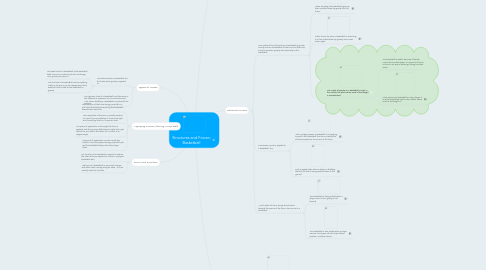
1. Types of Loads
1.1. The static loads on a basketball are the loads which gravity is applied to.
1.1.1. The dead load of a basketball is the basketball itself, since it is constant and will not change. Also, gravity acts upon it.
1.1.2. The live load of a basketball can be anything, really, as long as is can be changed and only external force it adds to the basketball is gravity.
1.2. The dynamic load of a basketball could be wind or the different air pressures as it is moved around. Also, when dribbling, a basketball is pushed to the ground.
2. Applying Forces (during Jump Ball)
2.1. The direction of the force during jump ball is a pull, since the players are pulling the basketball towards their own side.
2.2. The magnitude of the force is usually medium, as it won't be very effective if it were too light, and it would go too far if it was too hard.
2.3. The plane of application is the angle the force is applied, and during jump ball players usually try to get the ball to one side or the other, so it is often a 45 degree angle.
2.4. The point of application is most usually the bottom, since the players doing jump ball try to get the basketball before the other player does.
3. Form and Function
3.1. The function of a basketball is simple: to endure the external forces applied to it when it is played basketball with.
3.2. The form of a basketball is round and orange, with black lines running along its sides. It is not exactly made for its looks.
4. Types of Structures
4.1. A basketball is a shell structure, due to its rounded shape, which means the weight of the structure is distributed throughout, and the inside is hollow.
4.2. A basketball is not a solid structure because it is hollow, while solid structures are "solid" throughout.
4.3. Neither is a basketball a frame structure; as you can see, it does not have a network of parts, or a frame, as some might call it.
4.4. Considering a basketball only fits the description for one type of structure, being a combination structure is out of the question.
5. External Forces
5.1. One external force that acts on a basketball is gravity. Gravity acts on a basketball all the time, but there are some times when gravity acts especially on the basketball.
5.1.1. When shooting, the basketball goes up, then is pulled down by gravity into the hoop.
5.1.2. Other times, like when a basketball is bouncing, it is then pulled down by gravity and comes down again.
5.1.3. The center of gravity on a basketball is right in the middle, the place where most of the weight is concentrated.
5.1.3.1. The basketball is stable, because it literally cannot be knocked down; it is equal all around, so there is no way of defining it being knocked down.
5.1.3.2. When spinning a basketball on one's finger, it must be supported right in the middle, where most of the weight is.
5.2. Sometimes a push is applied to a basketball, too.
5.2.1. When a player passes a basketball, it is applying a push to the basketball; the force is taking the structure away from the source of the force.
5.2.2. Push is applied also when a player is dribbling the ball; the ball is being pushed down to the ground.
5.3. A pull, when the force brings the structure towards the source of the force, also occurs to a basketball.
5.3.1. The basketball is being pulled when a player saves it from going out of bounds.
5.3.2. The basketball is also pulled when a player secures it and goes into the triple threat position, as shown above.

